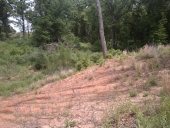

Adam Buchler wrote:I recently made several large raised beds...some of them 50+ feet in length. I built them by digging out the foot paths and piling the dirt up adjacent to form several rows of raised beds. However, I over looked the fact that they were not on contour and now a single rain event foods the foot paths very severely. My original plan was to fill up the foot paths with 6-10" of wood chips but now there is too much water. it does drain but very very slowly. It usually rains again before they have a chance to drain. Any suggestions on what I can do to fix this problem. I was going to try to move all that dirt to reorient the beds more to contour, however, now it will be hard to find contour with all those mounds of dirt. please help

Jack Edmondson wrote:Joshua,
The pond is a bit on the small side to have a substantial amount of 'free forage' fish. However, it is plenty big to raise catfish. They have the highest ratio of turning grain into protein than any animal and will eat anything...literally. No pond is too small to have 'some' fish, so it is really a matter of raising what you can for food or fun.
As far as the 5 acres, I can call BS. I have a couple of 1-2 acres ponds in the area that don't get fished much. I can pull 4-10 lbs of fish a day out of those lakes and I am not a fisherman. The fish are underfed. County agent says I need to pull about 30 #'s of little fish out of the water to reduce the pressure on the food source, if I want bigger bass. If 30#s of 'excess' fish can come out of a 2 acre pond, I don't believe a person needs 5 acres for a steady supply of fish.





Jd Gonzalez wrote:Here's an option, "straw book swales" it includes digging small swales on contour and filling them with "straw books" that are nothing more than sections of a square bale of hay. They act as sediment catchers (slows the water, slows erosion and will decompose adding organic matter to the slope) Add cover to the slope, wood chips, leaf mulch, and groundcover plants. Native grasses and sedges with deep roots and planted on countour come to mind also. Good luck!
http://permadesign.com/video#strawbookswales

Miles Flansburg wrote:Welcome to permies Joshua!
Do you have access to any heavy equipment, such as a backhoe? Or will you be doing any work done, by hand?
How much wood can you get your hands on? Anything from Logs to chips.

Dale Hodgins wrote:You should fix this damage in consultation with whichever authority is empowered to protect that creek. They'll know what works in your situation and you'll avoid later trouble. If you act independently, you may be blamed for the whole mess. There are usually free resources available to landowners who work to improve or rehabilitate a waterway.





